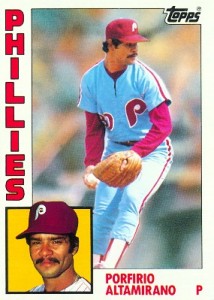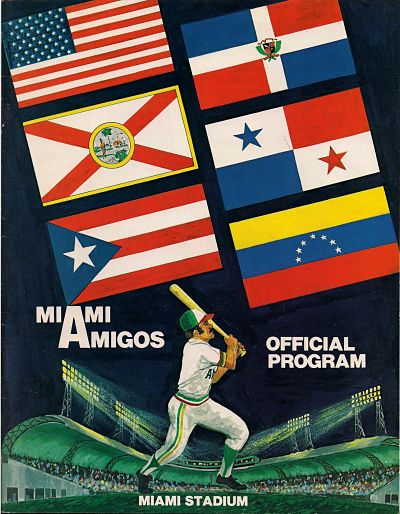Tombstone
Born: September 13, 1978 – Inter-American League founding franchise1Schatz, Willie. “Now you’ve got some friends in Miami Stadium”. The Miami News (Miami, FL). September 14, 1978
Folded: June 30, 19792Janofsky, Michael. “IAL Folds; Seeks 1980 Return”. The Herald (Miami, FL). July 1, 1979
First Game: April 11, 1979 (L 6-5 @ Panama Banqueros)
Last Game: June 30, 1979 (L 3-2 @ Maracaibo Petroleros)
Inter-American League Championships: None
Stadium
Miami Stadium
Opened: 1949
Demolished: 2001
Ownership & Affiliation
Owners: Ronald Fine and Joe Ryan
Major League Affiliation: Independent
Background
Roberto “Bobby” Maduro dreamed of forming a pan-Caribbean professional baseball league, linking the hardball-crazed tropical capitals of the sport by air: the Dominican Republic, Puerto Rico, Panama and Venezuela. Everywhere but his native Cuba, that Soviet farm club drifting 90 miles off the coast of Florida. Maduro knew Cuban baseball as well as anyone. He owned the Class AAA Havana Sugar Kings of the International League from 1954 to 1960 before the Revolution cost him his ball club and all of his property. He settled in South Florida’s Cuban exile community in 1961. It was Miami that would fill in spiritually for Cuba when Bobby Maduro formed the Inter-American Professional Baseball League in the fall of 1978.
Maduro announced the birth of the Miami Amigos on September 14th, 1978. Ronald Fine and Joe Ryan, owners of the Class A Miami Orioles of the Florida State League, would own both ball clubs who would share Miami Stadium. The Orioles/Amigos even sold a combined season ticket, for the masochist who wanted to wrap himself in Miami’s blanket of sweltering humidity for 130 ballgames each summer.
Triple-A Classification
Maduro called in connections from a lifetime in the game to get his vision off the ground. He worked for Major League Baseball Commissioner Bowie Kuhn for more than a decade as a special assistant on Latin American baseball. Amigos owner Joe Ryan was another key figure. In addition to his Miami Orioles investment, he served as President of the American Association, one of the three U.S. minor leagues recognized as triple-A by Minor League Baseball’s governing body, the National Association of Professional Baseball Clubs. Departing National Association President Bobby Bragan managed winter league ball in pre-Revolutionary Cuba and knew Maduro well. On his way out the door in late 1978, Bragan gave final approval to confer triple-A status on Maduro’s upstart league for the 1979 season.
There were six teams for the 1979 season, including the Amigos, the Caracas Metropolitanos and the Maracaibo Petroleros (Oilers) in Venezuela, the Panama Banqueros (Bankers), the San Juan Boricuas in Puerto Rico, and the Santo Domingo Tiburones (Sharks) in the Dominican Republic. Unlike other triple-A leagues, the Inter-American League was composed entirely of independent clubs with no Major League affiliations. On the down side, this meant that the teams were responsible for all of their own expenses. This burden would contribute to the Inter-American League’s eventual undoing. On the bright side, independent clubs could sign – and keep – any players they wished. They could focus on winning rather than developing players for the parent club.
Meet The Amigos
 The Amigos brought on former Baltimore Orioles All-Star Davey Johnson as player/manager. It was the first managerial experience for Johnson, who would go on to win a World Series at the helm of the New York Mets seven years later. Johnson’s charges included a league-high thirteen players with Major League service time. A few of the more prominent names:
The Amigos brought on former Baltimore Orioles All-Star Davey Johnson as player/manager. It was the first managerial experience for Johnson, who would go on to win a World Series at the helm of the New York Mets seven years later. Johnson’s charges included a league-high thirteen players with Major League service time. A few of the more prominent names:
Danny “The Sundown Kid” Thomas, whose once promising career with the Milwaukee Brewers was derailed by psychiatric problems, a suicide attempt, and his membership in the Worldwide Church of God. Thomas’ religious fixations prohibited him from playing baseball on the Sabbath.
Cuban-born pitcher Oscar Zamora played in the Majors just the previous summer with the Houston Astros. Zamora only showed up to work when was scheduled to pitch. He spent the rest of the time tending to his shoe business in Miami.
“Bullet” Bob Reynolds was a 1st round draft pick in 1966 who threw 100 miles per hour as a high school phenom in Seattle. 35-year old slugger Hal Breeden was just back in the States after mercenary work in the Japanese Central League.
Washed Away
The Inter-American League debuted in April 1979. From the outset problems both natural and man-made plagued the organization. Tropical rains washed out large numbers of games. Visa and airline snafus turned inter-Carribean travel into a nightmare and resulted in cancelled games. The Venezuelan teams drew well, particularly Caracas who pulled larger crowds on average than the Oakland A’s. But entrenched winter league interests in Puerto Rico set out to destroy the San Juan Boricuas club. The Boricuas occasionally drew fewer than 100 fans to Bithoron Stadium. Owners were undercapitalized and unreliable. In mid-June, the owners in San Juan and Panama walked away from their clubs. Players were left stranded across the Carribean, trying to make their way home with rubber paychecks in their pockets.
The End
In Miami, the Amigos had their own troubles. Davey Johnson underwent back surgery and missed most of the chaotic final weeks of the league.
Danny Thomas, leading the league with six home runs in early June, began to unravel emotionally yet again. The slugger already missed one and sometimes two games a week due to his religious observances. Now he began getting thrown out of games for angry tantrums with umpires. Davey Johnson suspended Thomas, who then visited a nutritionist he found through the Worldwide Church of God. The nutritionist attributed Thomas’ anger problems to low blood sugar and put him on a cleanse diet that included drinking 80 ounces of distilled water and molasses a day. It was a diagnosis that tragically misread the severity of Thomas’ psychiatric problems.
The Inter-American League limped along for two more weeks after San Juan and Panama folded. The league played its final games on the evening of June 30th, 1979. Then the league disbanded in the middle of the night. The Amigos finished with the best record in the league at 51-21. Acccording to Baseball-Reference.com, the club averaged 1,350 fans at home.
Aftermath
 Nicaraguan pitcher Porfirio Altamirano was the only Amigo who managed to use the Inter-American League as a springboard to (or back to) the Major Leagues. He played parts of three seasons with the Philadelphia Phillies and Chicago Cubs from 1982 to 1984.
Nicaraguan pitcher Porfirio Altamirano was the only Amigo who managed to use the Inter-American League as a springboard to (or back to) the Major Leagues. He played parts of three seasons with the Philadelphia Phillies and Chicago Cubs from 1982 to 1984.
Davey Johnson became manager of the New York Mets in 1984 and won a World Championship in 1986 at the age of 43. He later managed the Cincinnati Reds, Baltimore Orioles, Los Angeles Dodgers and Washington Nationals. Johnson also dabbled in sports investments as the founding owner of the Orlando Predators of the Arena Football League in the early 90’s.
Danny Thomas never played professional baseball again after the Inter-American League folded. His young family soon fell back into poverty in the Mobile, Alabama area and his severe psychiatric problems continued to plague him. In June 1980, he was arrested on charges of raping his family’s 12-year old babysitter. Soon afterward, Thomas hanged himself in his jail cell.
Amigos and Orioles owner Ronald Fine passed away in 1988 at the age of 58.
Roberto Maduro passed away at the age of 70 in 1986. Miami Stadium, the home of the Amigos, was renamed Bobby Maduro Stadium in his memory the following year. The stadium continued to host baseball events of various types through mid 1990’s. Developers demolished the stadium in 2001.
Downloads
1979 Miami Amigos promotional one-sheet
1979 Miami Amigos One-Sheet##


8 Responses
Hi Andy,
I worked for the Amigos while in college in Miami in 1979. Everything from ticket taker, to security to whatever was needed on gameday. Very few attended the games. I’m not sure I ever saw 1,300 fans at the stadium. maybe 200-300 at best. Somewhere I have their game program. Good memories…
Would like to see a roster with uniform numbers of the players … can you help
Miami amigos 1979 player roster with uniform jersey numbers … can you help??
I played with the Panama Banqueros infielder Jose Garcia number #2. was a dream come true with Major League players.
Hello Jose— how you doing?
All good with grandkids teaching them about the game and showing who I played with on the Panama Banqueros in 1979.